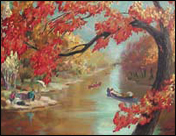Arts and Cultural Entrepreneurship
- C. Kurt Dewhurst
- Department of English
- College of Arts and Letters

Banks of the Red Cedar, John S. Coppin, 1954. Oil on canvas. Located in the Hannah Administration Building.
Over the last five years there has been a growing recognition that the creative economy is only just beginning to be understood and harnessed as a tool for community development. Richard Florida's (2002) groundbreaking book, The Rise of the Creative Class: And How It's Transforming Work, Leisure, Community and Everyday Life, has become much cited as the economist presents a "creativity index" for ranking cities and communities to determine their competitiveness for success in the twenty-first century knowledge economy.
Florida argues that "in today's global economy, the places that attract and retain talent will win, and those that can't will lose." In a chapter in his follow-up book, The Flight of the Creative Class: The New Global Competition for Talent (2005), Florida declares that "universities are the intellectual hubs of the creative economy. Universities foster technology, and the other two Ts of economic growth, talent and tolerance."
Florida also expresses concern that "with budget cuts in U.S. public higher education, the system has become less and less accessible to those who need it most ... we must begin to think of creativity as a common good like liberty or security. It's something essential that belongs to all of us, that must always be nourished, renewed, and maintained— or else it will slip away."

A new sculpture, added within the last year, is Twyla, by Bill Barrett. It is located near the new Grand River parking structure.
Michigan has embraced the power of the creativity economy and has been a leader in reinventing state government by creating an Office of Cultural Economic Development in the Department of History, Arts, and Libraries. This office has worked across state government to create the "Cool Cities" initiative and other innovative strategies to retain and attract the "creative class."
In the words of Betty Boone, director of the Office of Cultural Economic Development, "Growing entrepreneurship and jobs is a primary objective of the Cultural Economic Development Strategy to leverage Michigan's creative talent and cultural assets to spur economic growth and build community prosperity" (2006, p. 1).
Michigan State University has been an active collaborator with both the State of Michigan and communities across the state to transform the thinking and actions necessary to build effective and vital communities for the future through engaged scholarly work.
![Euclidean Iris, Austine Wood-Comarow [no date]. Backlit acrylic. Located in the Kellogg Center.](images/euclideanIris.jpg)
Euclidean Iris, Austine Wood-Comarow [no date]. Backlit acrylic. Located in the Kellogg Center.
MSU engaged scholars bring a new set of tools to their work. They work with community partners in an equitable way that values mutually agreed upon (or "co-created") outcomes.
Faculty members and academic specialists across the MSU campus are involved in a wide variety of cultural research projects and community development initiatives, both in Michigan and across the globe. They are bringing their knowledge to bear by developing new economic models for measuring the cultural economy; working with communities to conduct cultural asset inventories, documentation and mapping research that can provide the foundation for a creative future; building cultural-destination tourism; helping develop local craft and design industries; building accessible travel databases; teaching cultural entrepreneurial skills; and creating arts and culture-based trails as part of the growing scholarly interest in arts, culture, and entrepreneurship.
University-engaged scholars are also playing critical leadership roles in helping convene key community stakeholders and content experts to establish innovative entrepreneurial research teams. Many of these efforts are moving beyond the local community level to regional strategies that are built on place-based cultural assets shaped by attention to authenticity and excellence. Another significant outcome of successful cultural entrepreneurial work is advancing cross-cultural understanding in a diverse society—enhancing tolerance—one of Richard Florida's three T's that are instrumental for a creative economy.
As we move into the twenty-first century the vital interconnections between science, technology, culture, and creativity are being realized in new ways that are enriching the lives of those in Michigan and around the world.
MSU Cultural Engagement Council
The MSU Cultural Engagement Council (CEC) is composed of leaders of allied cultural units, outreach, and student life. The CEC strives to increase the visibility of campus cultural resources and expand MSU cultural engagement among our students and across Michigan, nationally, and internationally. The CEC seeks to build among students and the community a common understanding of the importance of culture through new and innovative partnerships and collaborations, and to enhance teaching and research in all aspects of the study of culture.
Public Art on Campus
The Public Art on Campus (PAOC) Committee was established in 1999 by a resolution of the MSU Board of Trustees "to advance the presence of public art on campus."
There are over 900 artworks catalogued in the PAOC Web site.
For more information, visit publicart.msu.edu.
- Written by C. Kurt Dewhurst, University Outreach and Engagement